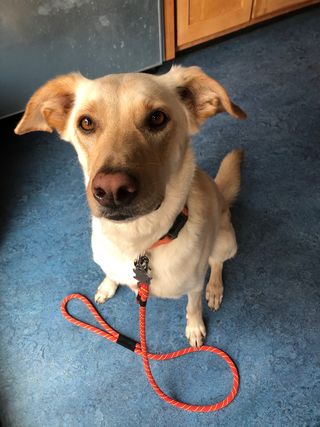The other day I was running by my house with my dog and we passed a man with a small terrier. My 50-pound lab mix was on her leash. The little dog was not. As we ran by, I told my girl to “leave it” and she ignored the terrier. The tiny beast sprinted after us, roaring like an elephant seal, and bit my dog in the rear. She whirled around and pinned him to the ground with her chest, baring her teeth. She didn’t hurt him but elegantly delivered the message that she could end his tiny life if she wanted to. I pulled her off, and the screaming terrier ran back to its owner, who had now sauntered close enough to hold the creature’s collar.
“He does that sometimes,” the guy said as his dog continued to yelp in fear. My girl was now sitting with her tail tucked around her feet and looking past them at a squirrel as if they weren’t there at all. “I guess I should maybe keep him on a leash.”
I live in a small town, where anonymity is something we trade in for a senes of community. We do not have the liberty to honk our horns, take cuts in line or yell at strangers. So although there was much I wanted to say in reply, I just agreed with him that a leash was a probably good idea.

Let me say that I am a big fan of leash-lessness. I agree with author Temple Grandin, who writes in her book, Animals Make Us Human, that leashes and fences make dogs feel confined and contribute to aggression. If a dog can behave without a leash, I wholeheartedly support its right to do so. But, as has been illustrated, sometimes they can’t, and it’s their humans’ responsibility to control their behavior.
My own girl was perfectly fun and friendly off-leash when she was a puppy and a young dog. Two ACL surgeries later, she has developed an attitude problem. It appears to be situational; she doesn’t like to pass other dogs, especially face to face (and of course nobody likes to be bitten in the rear). We are working on it and she is learning to control her grumpiness. But when she’s going to be in a situation that will trigger her, I recognize that since I’m responsible for her safety and the consequences of her behavior, I’ve got to be the one in charge.
I was thinking about all this when I went to the grocery store later. Spanish language mass had just ended at the nearby church and youth soccer season was in full swing, so the place was packed with families with young kids. I saw a woman come out of the store carrying her groceries and squiring a toddler who was just old enough to walk. The kid tripped along next to her, careening wildly and wind-milling his arms with a huge smile on his face. They were firmly connected by a leash.
Over the years, I have heard this debate about child leashes flare up time and time again. I’m not a parent, but I am a first-rate backseat parent, and I have developed my own opinion on this and many other facets of raising children. Regarding the use of child leashes, I can’t understand what the fuss is all about. It seems like a perfectly reasonable way to keep your kid safe and your hands free. And it’s not like we’re talking about a neck collar. These are cute little backpacks with tethers on them. Those who object say the practice is humiliating to kids or signals lazy parenting, but nobody seems to object to strollers, which could be accused of doing the same. A friend once told me about being abroad and wheeling her young child around in a big Graco stroller. A friendly local looked at the lolling child and politely inquired what was wrong with the boy that he couldn’t walk around on his own. Yes, yes, like I said — backseat parent. Still, strollers offer their own kind of confinement and don’t allow kids to get exercise, either.
In my family of five children born in six years, my sister Margaret was the only one that was ever tethered. When we were little, she didn’t talk much and lived very much in her own world of autism. Margaret wasn’t afraid of anything and had a habit of wandering off on her own to explore. She’d disappear on her bicycle from our suburban neighborhood to be found miles away trundling down the county highway. Sometimes she’d let herself into a neighbor’s house to make a sandwich even if we didn’t know that neighbor (even more regrettable if the neighbor happened to be, let’s say, in the bathtub). At the lake cabin, my mother worried about her getting lost in the woods or falling in the lake, or running afoul of the occasional person shooting his gun up in the trees. So, when she was busy in the house and couldn’t watch her, she decided to clip Margaret’s lifejacket to a length of rope. Years later she told me how she had struggled with this decision. Was it right to constrain my sister like this? Was it disrespectful to tether Margaret just because she had a disability? One day as she grappled with this moral quandary, she watched my sister unclip herself, come inside for a drink, return to the beach and clip herself back into the rope.
That was a classic Margaret move that still makes us laugh. I don’t know what was going through her head. Margaret is intelligent in ways that baffle, but can’t communicate in typical ways that the rest of us do. In any case, she seemed to be respecting the boundary that Mom had set, and she knew Mom loved her. I believe the same thing is going on with Pita. She understands that I, at the other end of the leash, love her and I’m in charge. She will do her best to listen, though all bets are off if some bites her in the rear. While I’m not equating my sister and my dog here, I will say that Margaret has taught me loads about the power of non-verbal communication and what we can learn if we pay close attention to the people and creatures we love.
On the return leg of that trail run, we came upon another off-leash dog, and Pita listened when I told her to sit to the side. She was trusting me that I would not let this situation repeat the last. The other dog wandering toward us, curious to investigate. Its owner was deep in conversation on her phone, waving her free hand and looking up at the trees. As I stood between the two dogs and waited for them to pass, the woman saw me and halfheartedly called her dog, who ignored her and padded closer to us. “No,” I said pointing down the trail. “Go on now.” The owner stopped on the trail below and called her dog again. “No! No! I am paying attention,” she insisted into the phone. I turned with Pita and headed off toward home.


